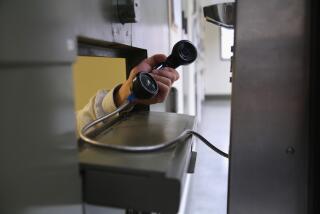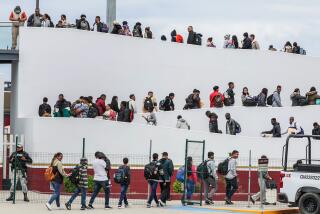Opinion: How to help Trumpâs immigration detainees escape from Otay Mesa, one letter at a time
Stories of asylum seekers crowd my thoughts.
Thereâs Thomas, from the Democratic Republic of the Congo, whoâs been in custody at Otay Mesa Detention Center in San Diego for two years and eight months, after his escape from an oppressive regime that has detained hundreds of pro-democracy and human rights activists. Thereâs Andres, who fled gangs in El Salvador, holding on to his evangelical faith to ease the pain of separation from his family and his inability to inform them as to how or where he is. From Eritrea, thereâs Fxum, who fled because âmy country is bad condition and the government is dictator. ⌠I run away to save my life in America.â
But none of them are saved.
I know something of their stories because for the last four months, Iâve been a letter writing volunteer with Detainee Allies, an advocacy group that, among other things, matches people like me with men and women in ICE detention at Otay Mesa. They see my letters via email; I read theirs posted weekly (full names redacted) on a private Google drive where responses to all the volunteersâ letters are shared. I canât get the detainees out of custody or argue their asylum cases, but writing letters to support them is something I can do.
I learn the nightmares they are fleeing, the texture of their lives. They learn that there is a community that will not let them remain voiceless, nameless, disappeared behind Immigration and Customs Enforcement prisons such as Otay Mesa, run by CoreCivic , a corporation that describes itself on its website as offering âgovernmental real estate solutions.â
One detainee, Horacio, explains in a letter that his favorite music group is the Bee Gees and that he loves Clint Eastwood, a âvery good actor for Western movies.â He knows American movies because his parents brought him to the U.S. when he was 16 years old. He took English classes and harvested broccoli, strawberries, cauliflower and artichokes in the Salinas Valley. He says he is terrified of being sent to Mexico, âwhere massive killings are happening.â He eases his correspondentâs worries that an account of summer travels will only make him feel worse:
âI can imagine everything in my mind about what you do every day in your house and believe me I know where Maine is I know the names of all the states of USA ⌠sometime I used to go to those cities that are by the sea like .Monterey, Santa Cruz just to take walks and to talk with the American people that honestly were and are very nice and kind and I remember I loved to make conversation with that people just to improve my English [⌠] people in that area are honestly so sweet and is always are willing to help you I know that most of the American people are like that, I can say that because through the years that I lived here I had such a good memories with the people from this country.â
A young man named Mohammed writes that he was tortured in his home country of Yemen. His letter includes what he wants to convey to his asylum judge, should he ever have the opportunity to appear before one:
Honorable Judge,
I hope that you will give me the right of protection and let me live in this country like any citizen. For I pledge to you that I will serve this country and will work to build it up night and day and will take care of it as I take care of the pupil of my eye, and I will be a trustworthy watchman for it and contributing member of society, not a destructive one.
In August , representatives from Detainee Allies joined a delegation from the California Legislative Jewish Caucus that was granted rare access into Otay Mesa. I read their report. What the detainees told them was gut-wrenching and well-known by now â Customs and Border Protection kept them in freezing holding cells (hieleras), sometimes with lights on 24/7 and nothing but a Mylar wrap and a Âźâ pad cushioning them from the cold concrete.
At Otay Mesa, refugees and asylum seekers have extremely limited access to legal help, family and the outside world in general; they report racist guards, medical neglect and solitary confinement as a punishment. CoreCivic, the nationâs largest owner of partnership detention facilities, denies it all.
Out of 1,412 inmates in federal detention at Otay Mesa in August, 978 were ICE detainees, from 73 different countries, according to Detainee Allies. They were paid about $1/day to join a âvoluntaryâ labor program, working as janitors, landscapers and in the laundry, which has to represent a cost savings for CoreCivic. For the first quarter of 2019, the corporation reported a year-to-year 31% increase in net income.
I struggle each week to think how to bolster the spirits of someone who has endured CBP and ICE detention conditions in a nation founded on the idea of offering safe haven to those fleeing persecution, violence. That need for refuge is part of my own family history â my father and my grandparents fled Russia during a civil war in 1921, starting a new life in the United States.
What can I tell Esperanza, a young Guatemalan, detained at Otay Mesa for two months and 22 days, who writes, âI came because my country of violence is too much today only God knows our suffering. I hope to get out.â
I describe to Esperanza the Lights for Liberty demonstration in downtown Los Angeles in July, how the crowd shined flashlights up toward those slits that pass for windows in the Metropolitan Detention Center, where ICE houses some migrants. Lights inside the tower blinked on and off in response. I was there as the crowd of a thousand Angelenos chanted up to them: âNo estas solo!â You are not alone.
Louise Steinman founded the Aloud lecture series at the Los Angeles Public Library and curated it for 25 years. She is the author of âThe Souvenir: A Daughter Discovers Her Fatherâs War.â San Diego State University maintains an archive of Detainee Allies letters that have been cleared for online publication.
More to Read
A cure for the common opinion
Get thought-provoking perspectives with our weekly newsletter.
You may occasionally receive promotional content from the Los Angeles Times.










